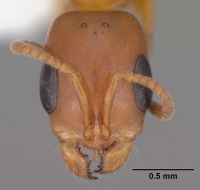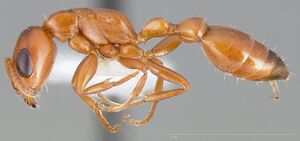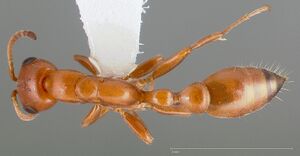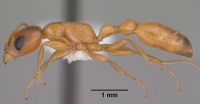Pseudomyrmex apache
| Pseudomyrmex apache | |
|---|---|

| |
| Scientific classification | |
| Kingdom: | Animalia |
| Phylum: | Arthropoda |
| Class: | Insecta |
| Order: | Hymenoptera |
| Family: | Formicidae |
| Subfamily: | Pseudomyrmecinae |
| Genus: | Pseudomyrmex |
| Species group: | elongatulus |
| Species: | P. apache |
| Binomial name | |
| Pseudomyrmex apache Creighton, 1953 | |
Pseudomyrmex apache occurs widely across the southwestern United States from northern California to east Texas, and south into adjacent northern Mexico (Fig. 19). This species inhabits a variety of xeric habitats, including chaparral, coastal sage scrub, mesquite scrub, oak woodland, and oak-pine-juniper woodland, nesting in dead branches of various woody plants, especially Arctostaphylos, Baccharis, Prosopis, and Quercus. Colonies are polydomous—occupying multiple dead branches within a tree or shrub—and they contain one to several inseminated queens (Ward 1985). For locality records with elevation, the range is 20 m to 2,020 m (mean 905 m; n = 145). In addition to the examined material listed above, we have seen one old worker labeled as coming from Washington, DC. (24 Aug 1919, leg. B. P. Currie) (USNM). We judge this to be either mislabeled or representing an accidental introduction. (Ward & Branstetter, 2022)
Desert habitats, especially oak and mesquite areas. Pseudomyrmex apache nests in oak trees and large mesquites, usually in the largest and most inaccessible dead branches that have living tissue at the base. Most of the galleries galleries are constructed by wood boring beetles. (Mackay and Mackay 2002)
Identification
Medium-sized species (HW 0.88–1.00) with moderately elongate head (CI 0.80–0.84) (Fig. 4) and relatively short eyes (see REL and REL2 values); frontal carinae separated by about basal scape width or slightly less; metanotal groove present but weakly impressed; in profile, dorsal face of propodeum almost flat and more or less differentiated from declivitous face, rounding into the latter, and the two faces subequal in length; petiole relatively short and high (PLI 0.55–0.61, PL/ HL 0.48–0.54), with a slight anterior peduncle; profemur slender; hind leg relatively short (LHT/HL 0.69–0.73). Head subopaque, densely punctulate-coriarious. Standing pilosity sparse, absent from propodeum and (nearly always) the mesonotum (MSC 3–8). Uniformly light yellow- to orange-brown, the tip of gaster usually infuscated. (Ward & Branstetter, 2022)
P. apache is closely related to Pseudomyrmex championi, and our UCE phylogeny recovers it nested phylogenetically within that species (Fig. 1). The main distinction between the two taxa rests on body color: workers of P. apache are concolorous yellow- or orange brown, whereas those of P. championi are bicolored with at least the gaster and hind leg dark brown and contrasting with the lighter orange-brown mesosoma (other body parts are usually dark brown but in some individuals they are concolorous with the mesosoma). The distinction is a slight one, but where the two species are geographically adjacent to one another in Sonora and Chihuahua (Figs. 19 and 21) the color differences appear to be sustained. For the moment, we treat P. apache as a distinct species, presumably recently derived from P. championi, in a daughter and parent relationship that renders P. championi paraphyletic at most loci. Nevertheless, further study of populations in northwest Mexico is desirable; it might reveal evidence of gene flow between the two taxa. P. apache can also be confused with Pseudomyrmex arcanus, a more distantly related species in the P. elongatulus group, whose workers are similarly colored (light yellow- to orange-brown) but have more elongate eyes and a more gently rounded propodeum and petiole (see under P. arcanus for more discussion). (Ward & Branstetter, 2022)
Keys including this Species
Distribution
Known from the southwestern USA (TX, NM, AZ and CA) and Mexico.
Latitudinal Distribution Pattern
Latitudinal Range: 40.98333333° to 21.800206°.
| North Temperate |
North Subtropical |
Tropical | South Subtropical |
South Temperate |
- Source: AntMaps; Ward & Branstetter, 2022
Distribution based on Regional Taxon Lists
Nearctic Region: United States (type locality).
Neotropical Region: Mexico.
Distribution based on AntMaps
Distribution based on AntWeb specimens
Check data from AntWeb
Countries Occupied
| Number of countries occupied by this species based on AntWiki Regional Taxon Lists. In general, fewer countries occupied indicates a narrower range, while more countries indicates a more widespread species. |

|
Estimated Abundance
| Relative abundance based on number of AntMaps records per species (this species within the purple bar). Fewer records (to the left) indicates a less abundant/encountered species while more records (to the right) indicates more abundant/encountered species. |

|
Biology
Ward (1985):
A denizen of xeric habitats, P. apache nests in sizable dead branches (1-12 cm diameter) of various trees (especially live oaks) and large woody shrubs, usually taking advantage of beetle-bored cavities. By state and country, nest-site records are as follows:
Texas: Prosopis glandulosa, Quercus grisea.
Arizona: Populus sp., Prosopis sp., Quercus arizonica, Q. emoryi. Q. grisea;. Q. oblongifolia, Q. turbinella.
California: Arctostaphylos manzanita, Fraxinus gall, Pinus attenuata cone, Quercus chrysolepis, Q. wislizenii, Umbellularia californica.
Mexico: Prosopis sp., Quercus emoryi, Q. fusiformis, Q. oblongifolia, Q. santaclarensis.
Of 13 nests which I have dissected (from Texas, Arizona and California), five contained no dealate females, six contained a single queen, one contained two functional (i.e. inseminated) queens, and one contained 6 dealate queens. Thus this species is at least occasionally polygynous and (judging from the queenless nests) polydomous. For two of the five queenless nests, queenright nests were located on the same tree or shrub.
I have seen two instances of lone foraging (presumably colony founding) dealate queens: one on the trunk of a Quercus arizonica tree in September (Arizona) and the other on an Arctostaphylos bush in February (northern California). The latter queen was dissected and found to be inseminated but possessing preoviposition ovaries (ovarioles short; corpora lutea absent). Alates of P. apache have been collected in March, April, and July to November, suggesting that mating may occur in more than one season.
Flight Period
| X | |||||||||||
| Jan | Feb | Mar | Apr | May | Jun | Jul | Aug | Sep | Oct | Nov | Dec |
Source: antkeeping.info.
- Check details at Worldwide Ant Nuptial Flights Data, AntNupTracker and AntKeeping.
 Explore: Show all Flight Month data or Search these data. See also a list of all data tables or learn how data is managed.
Explore: Show all Flight Month data or Search these data. See also a list of all data tables or learn how data is managed.
Castes
Worker
Images from AntWeb
   
| |
| Worker. Specimen code casent0005440. Photographer April Nobile, uploaded by California Academy of Sciences. | Owned by UCDC, Davis, CA, USA. |
Male
  
| |
| . | |
Phylogeny
Relationships among Pseudomyrmex elongatulus group species based on Ward & Branstetter (2022).
| Pseudomyrmex |
| ||||||||||||||||||||||||||||||||||||||||||||||||||||||||||||||||||||||||||||||||||||||||||
Nomenclature
The following information is derived from Barry Bolton's Online Catalogue of the Ants of the World.
- apache. Pseudomyrmex apache Creighton, 1953b: 134, pl. 12, figs. 1-7 (w.q.m.) U.S.A. Wheeler, G.C. & Wheeler, J. 1956: 380 (l.). See also: Creighton, 1954: 9; Ward, 1985b: 229.
Unless otherwise noted the text for the remainder of this section is reported from the publication that includes the original description.
Ward (1985) - Although I have placed P. apache in the pallidus group as a matter of convenience, it is a rather distinct species showing only superficial resemblance to other members of the group. It is the only species to possess such well separated frontal carinae, laterally rounded anterior clypeal margin, short eyes relative to scape length, and (in the male) ventrally pointed pygidium. P. apache workers also tend to be larger, more densely sculptured (hence less shiny), and more setose than those of other pallidus group species. Size alone (worker HW > 0.83 ) will separate P. apache from all species except Pseudomyrmex pallidus and Pseudomyrmex seminole. Apart from character differences outlined in the keys (of which eye size relative to scape length and shape of male terminalia are most distinctive) P. apache can usually be distinguished from P. pallidus and P. seminole by the presence of a pair of erect setae, one on either side of the median ocellus, in the worker. In P. apache workers these two setae are always present and usually as long as the ocellar distance (OD). In P. seminole and P. pallidus workers these setae are either absent or shorter than OD.
Description
Worker
Measurements (n = 3 5): HL 1.02-1.30, HW 0.83-1.04, MFC 0.033-0.066. CI 0.75-0.84, OI 0.58-0.65, REL 0.39-0.44, REL2 0.48-0.54, PPI 1.10-2.00, VI 0.74-0.84, FCI 0.034-0.070, SI 0.46-0.51, SI2 0.90-1.00 FI 0.38-0.44, PDI 0.87-1.19, MPI 0.007-0.044, NI 0.51-0.64, PLI 0.54-0.61, PWI 0.48-0.56, PPWI 1.02-1.19.
Diagnosis. Head broad: eyes short (EL subequal to SL); anterior clypeal margin laterally rounded; frontal carinae subcontiguous, MFC subequal to the basal width of scape; occipital margin flat to broadly convex, in full-face, dorsal view; pronotum with weak lateral margination; metanotal groove usually weak; petiole relatively short, broad, and high with a rather sharply inclined anterior face. Head opaque to sublucid, densely punctulate on a coriarious background; mesosoma and petiole subopaque, coriarious-imbricate; postpetiole and gaster opaque to sublucid, covered with numerous, fine piligerous punctures. Erect setae sparsely present on scape, head, pronotum, petiole, postpetiole, gaster, and legs (generally absent on mesonotum and propodeum); typically four pairs of erect setae on dorsum of head, and two or three pairs each on pronotum, petiole, and postpetiole. Fine, appressed pubescence scattered over body, including fourth abdominal tergite. Rich orange-brown, the head (and sometimes legs and gaster) a little darker.
Type Material
- Ward (1985) - Nidoparatype workers, females, males, Brown Canyon. Baboquivari Mtns., Arizona. 4400 ft. 2.ix.1951, in Quercus oblongifolia 502 (W.S. Creighton) (Los Angeles County Museum of Natural History, Museum of Comparative Zoology) (Examined).
- Ward & Branstetter (2022) - Syntype workers, queens, males, Brown Canyon, Baboquivari Mtns., Arizona, 4400 ft., 2 Sept 1951, in Quercus oblongifolia (W. S. Creighton) (AMNH, BMNH, LACM, MCZC, MZSP) [examined].
References
- Creighton, W. S. 1953b [1952]. Pseudomyrmex apache, a new species from the southwestern United States (Hymenoptera: Formicidae). Psyche (Camb.) 59: 131-142. (page 134, pl. 12, figs. 1-7 worker, queen, male described)
- Creighton, W. S. 1954. Additional studies on Pseudomyrmex apache (Hymenoptera: Formicidae). Psyche (Cambridge) 61:9-15. [1954-06-30] (page 9, see also)
- Ward, P. S. 1985b. The Nearctic species of the genus Pseudomyrmex (Hymenoptera: Formicidae). Quaest. Entomol. 21: 209-246. (page 229, see also)
- Ward, P.S., Branstetter, M.G. 2022. Species paraphyly and social parasitism: Phylogenomics, morphology, and geography clarify the evolution of the Pseudomyrmex elongatulus group (Hymenoptera: Formicidae), a Mesoamerican ant clade. Insect Systematics and Diversity 6(1), 4: 1-31 (doi:10.1093/isd/ixab025).
- Wheeler, G. C.; Wheeler, J. 1956. The ant larvae of the subfamily Pseudomyrmecinae (Hymenoptera: Formicidae). Ann. Entomol. Soc. Am. 49: 374-398. (page 380, larva described)
References based on Global Ant Biodiversity Informatics
- Cokendolpher J. C., and O. F. Francke. 1990. The ants (Hymenoptera, Formicidae) of western Texas. Part II. Subfamilies Ecitoninae, Ponerinae, Pseudomyrmecinae, Dolichoderinae, and Formicinae. Special Publications, the Museum. Texas Tech University 30:1-76.
- Coronado-Blanco J. M., D. A. Dubovikoff, E. Ruiz-Cancino, M. Vasquez-Bolanos, K. Y. Flores-Maldonado, and J. V. Horta-Vega. 2013. Formicidae (Hymenoptera) del estado de Tamaulipas, Mexico. CienciaUat 25(1): 12-17.
- Cover S. P., and R. A. Johnson. 20011. Checklist of Arizona Ants. Downloaded on January 7th at http://www.asu.edu/clas/sirgtools/AZants-2011%20updatev2.pdf
- Creighton W. S. 1953. Pseudomyrmex apache, a new species from the southwestern United States (Hymenoptera: Formicidae). Psyche (Cambridge) 59: 131-142.
- Creighton W. S. 1954. Additional studies on Pseudomyrmex apache (Hymenoptera: Formicidae). Psyche (Cambridge) 61: 9-15.
- Dattilo W. et al. 2019. MEXICO ANTS: incidence and abundance along the Nearctic-Neotropical interface. Ecology https://doi.org/10.1002/ecy.2944
- Des Lauriers J., and D. Ikeda. 2017. The ants (Hymenoptera: Formicidae) of the San Gabriel Mountains of Southern California, USA with an annotated list. In: Reynolds R. E. (Ed.) Desert Studies Symposium. California State University Desert Studies Consortium, 342 pp. Pages 264-277.
- Johnson R. Personnal Database. Accessed on February 5th 2014 at http://www.asu.edu/clas/sirgtools/resources.htm
- Johnson, R.A. and P.S. Ward. 2002. Biogeography and endemism of ants (Hymenoptera: Formicidae) in Baja California, Mexico: a first overview. Journal of Biogeography 29:10091026/
- Mackay W. P., and E. E. Mackay. 2002. The ants of New Mexico (Hymenoptera: Formicidae). Lewiston, New York: Edwin Mellen Press, 400 pp.
- McDonald D. L., D. R. Hoffpauir, and J. L. Cook. 2016. Survey yields seven new Texas county records and documents further spread of Red Imported Fire Ant, Solenopsis invicta Buren. Southwestern Entomologist, 41(4): 913-920.
- O'Keefe S. T., J. L. Cook, T. Dudek, D. F. Wunneburger, M. D. Guzman, R. N. Coulson, and S. B. Vinson. 2000. The Distribution of Texas Ants. The Southwestern Entomologist 22: 1-92.
- Vásquez-Bolaños M. 2011. Lista de especies de hormigas (Hymenoptera: Formicidae) para México. Dugesiana 18: 95-133
- Ward P. S. 1985. The Nearctic species of the genus Pseudomyrmex (Hymenoptera: Formicidae). Quaestiones Entomologicae 21: 209-246
- Wetterer, J. K.; Ward, P. S.; Wetterer, A. L.; Longino, J. T.; Trager, J. C.; Miller, S. E. 2000. Ants (Hymenoptera: Formicidae) of Santa Cruz Island, California. Bulletin of the Southern California Academy of Sciences 99:25-31.
- Wetterer, J.K., P.S. Ward, A.L. Wetterer, J.T. Longino, J.C. Trager and S.E. Miller. 2000. Ants (Hymenoptera:Formicidae) of Santa Cruz Island, California. Bulletin of the Southern California Academy of Science 99(1):25-31.
- Wheeler, G.C. and J. Wheeler. 1985. A checklist of Texas ants. Prairie Naturalist 17:49-64.

